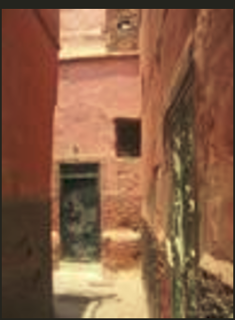
This article in the Upper Nile Times about the king of Morocco’s ‘vision’ for the country’s development through the preservation Jewish culture – an ‘act of interfaith’ – is followed by a disclaimer: it represents the owner’s own views. But it is hard to see how the chairman of the High Atlas Foundation, Dr Yossef Ben-Meir ‘s views might deviate from the official line. (With thanks: Boruch)
The Marrakesh Mellah
Since early in his reign, the King of Morocco has championed the premise of integrating cultural and sustainable development into single movements. The kingdom’s position in regards to the Alliance of Civilizations, for example, embodies the natural chemistry of actions that are both multicultural and developmental, as well as – in the case of the Alliance – meant to improve cooperation among nations. As King Mohammed VI explained in 2008: “That vision consists in making sure culture serves as a driving force for development as well as a bridge for dialogue.”
Moroccan-Jewish cemetery rehabilitation
One clear example that is occurring within Morocco (where cultural preservation and advancing the well-being of people work congruently) is regarding the national project launched in 2012 to rehabilitate the Jewish cemeteries. There are approximately 600 Hebrew “saints” that are buried in all parts of the kingdom. Many have laid in rest a millennium or more, and 167 of the sites have been part of the national preservation effort. Importantly, the Jewish community (starting in Marrakech) also began in 2012 to lend land to the High Atlas Foundation, a U.S.-Moroccan nonprofit organization, nearby seven of the sacred burials in order to plant organic fruit tree nurseries for the benefit of farming families and schools. Initial local efforts to preserve the Jewish cemeteries and lend land for community tree nurseries began in the 1990s, and has since been building to scale. Given that most poverty in the nation (and in the world) exists in rural places, and that Moroccan farmers are transitioning from traditionally growing barley and corn, the demand for more profitable fruit trees is therefore very significant.
Growing fruit trees from seedlings on land lent by the Moroccan Jewry (lent or abandoned? one wonders – ed ) and distributing them in-kind to marginalized rural communities not only meets a development priority, but is also an act of interfaith. The reinvigorated relationships between the Muslim farming families and Jewish community members leads to deepened appreciation among the beneficiaries of these historic religious places (even as the burial sites have been respected ever since their beginning). This multicultural initiative lends towards more goodwill due to the sustainable development results, and in turn increased social unity and actions of preservation. What maximizes the measure of solidarity (and sustainability), however, is that the farming communities themselves identified fruit trees and their varieties as a development priority. Therefore, the project responds to the expressed needs of the people and helps to deliver the outcomes they seek, illustrating how cultural benefits can be maximized when participatory human development is fully incorporated into their processes.
The Marrakech mellah and Jewish continuity
Now, let’s consider the rehabilitation of the mellah, the Jewish quarter which historians suggest first appeared in Marrakech during the second half of the 16th century. The Jewish experience in Morocco, and certainly in Marrakech, with all of its cycles and periods, can be characterized as quite remarkable in its longevity and quality. There are impressive scholars who have dedicated themselves to understanding specifically and thematically what has transpired in Marrakech in regards to Jewish life, thought, cultural evolution, practice, trials, and major stretches of peaceful pluralism. I personally have not given this level of consideration to the social developments that constitute the Jewish-Marrakech narrative. However, one can fairly state that Jewish life in Marrakech has been incredibly rich, complex, nonlinear, hopeful, painful, continuous, and ongoing to this very moment. Therefore, the initiative to preserve this living and evolving social artifact is exceptionally worthy, and an action fully consistent with the Moroccan national identity and Constitution.
I have often come up against this question of, why Morocco? Jewry had lived for millennia in Near Eastern nations, but no longer do; yet in Morocco they remain to this day, and are invited to return if they had left. When vandalism, violence, and rejection seems to characterize the Jewish experience to varying degrees at different times in many nations of the world, one might ask why this has not been the case in Morocco (a questionable assertion – ed) This question on one level may be as difficult to answer as is the question of why the Jewish people continue to exist as a cohesive group in the world at all. Why Morocco is an ongoing home (only just – it has lost 99 percent of its Jews – ed) when other nations have ceased to be, could invite an esoteric explanation, or one simply accepting that observers have yet to fully explain Moroccan-Jewish exceptionalism.
Read article in full

Leave a Reply